University and First Nation authors offer best-practices framework for community-based research
By Ben Young Landis
Mainstream academia is inherently Western in practice, structure, and world view. When confronted with questions in natural history or natural resource management, academics tend to impose their Western framework of knowledge gathering — at best undervaluing the wealth of indigenous expertise, at worst exploiting it for outside gain.
That’s the reason why Canadian conservation biologist Megan S. Adams takes care to identify herself as a “settler-academic” vis-à-vis her colleagues of indigenous heritage. As a scientist of non-indigenous descent, Adams respectfully frames her place and expertise when living and working in the stunning natural landscape of the Wuikinuxv, Heiltsuk, Kitasoo/Xai’xais, Nuxalk, and Gitga’at Coastal First Nations — the region Europeans colonized and named British Columbia.
Adams recognizes the damage and sensitivities caused by colonial actions of the past and present, in terms of cultural knowledge suppression and natural resource extraction. “Conducting science in a colonial landscape can be quite extractive,” Adams explains. “I try to reflect, and share my reflections, on how scientists can be better about how they do science, and how they can be more inclusive.”
Fortunately, traditional ecological knowledge is increasingly a focus of discussion within natural resource fields of study. But when it comes to standardized protocols for collaborative, community-engaged research, few references have been published for ecologists and earth scientists.
To address this gap, Adams teamed with her mentors at various Coastal First Nations stewardship agencies, Spirit Bear Research Foundation, Hakai Institute, and at the University of Victoria to draft such a reference. Their ideas culminated in a framework titled “De-Centering the University from Community-Based Research: A Framework for Engagement Between Academic and Indigenous Collaborators in Natural Resource and Conservation Research.”
It is an elegant set of recommendations that holds many applications for academics seeking to venture beyond their classical training — and embrace an ethic of respect when growing and sharing scientific knowledge.
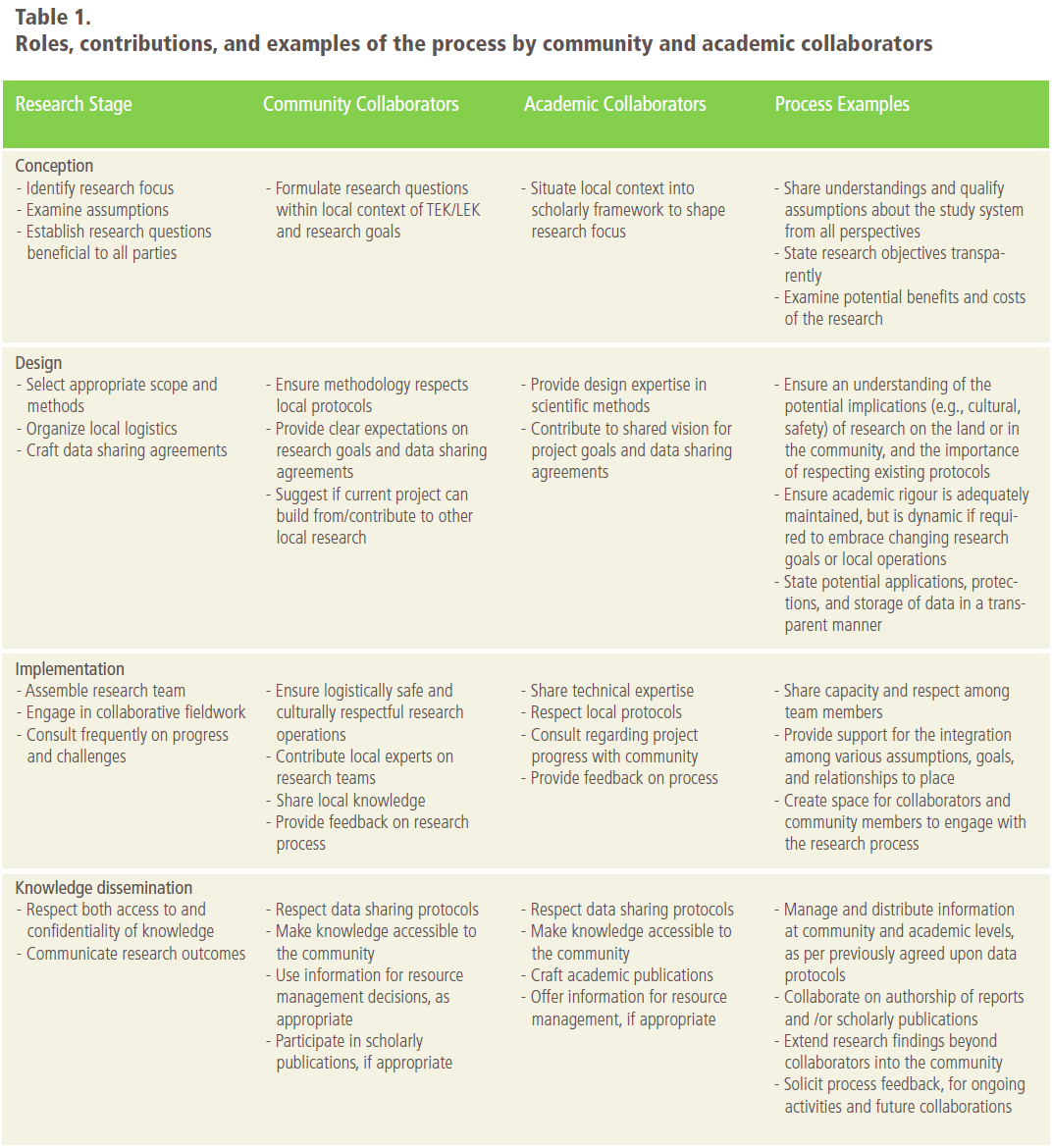
A framework for respectful community engagement research, as presented by Megan Adams with University of Victoria and Coastal First Nations collaborators. (Published in Toolbox on the Research Principles in an Aboriginal Context: Ethics, Respect, Equity, Reciprocity, Collaboration and Culture, First Nations of Quebec and Labrador Health and Social Services Commission, Centre de recherche en droit public, Université du Québec in Abitibi-Témiscamingue, 2014.)
Research Principles
The framework was published as a chapter in Toolbox of Research Principles in an Aboriginal Context, a handbook issued by the First Nations of Quebec and Labrador Health and Social Services Commission in 2015. Four authors from Western academic traditions and four authors from indigenous knowledge traditions contributed to the chapter.
Although inspired by their collaborative studies on grizzly and black bear conservation in Coastal First Nations territory, the framework penned by Adams and coauthors is structured to be adaptable across research topics and geographic contexts. Indeed, the recommendations focus on improving research process itself — on considering the research outcomes and consequences for the partner community, and on ways to ensure respect for that community.
“This framework may seem like reinventing the wheel,” says Adams, acknowledging that social sciences fields, such as anthropology and geography, have richer traditions in addressing community impacts and ethical implications in their methodology. “But to us, it seemed like these were things that needed to be shared with the natural sciences.”
A table summarizes the framework succinctly, offering recommendations for both the academic partner and the community partner — then sorting them for each stage in the research process: project conception, project design, project implementation, and knowledge dissemination.
Additional wisdoms dot the rest of the chapter, from the subtle (visiting academics ought to avoid phrases like “my study area”) to the fundamental (information gathered from indigenous knowledge holders rightfully remains their property, and should not be subsumed as the intellectual property of the academic institution).
“This process requires that each party seek to enhance its individual strengths,” the authors write in their opening, “and cultivate benefits from research by respecting and working together throughout the process.”
Redrawing Boundaries
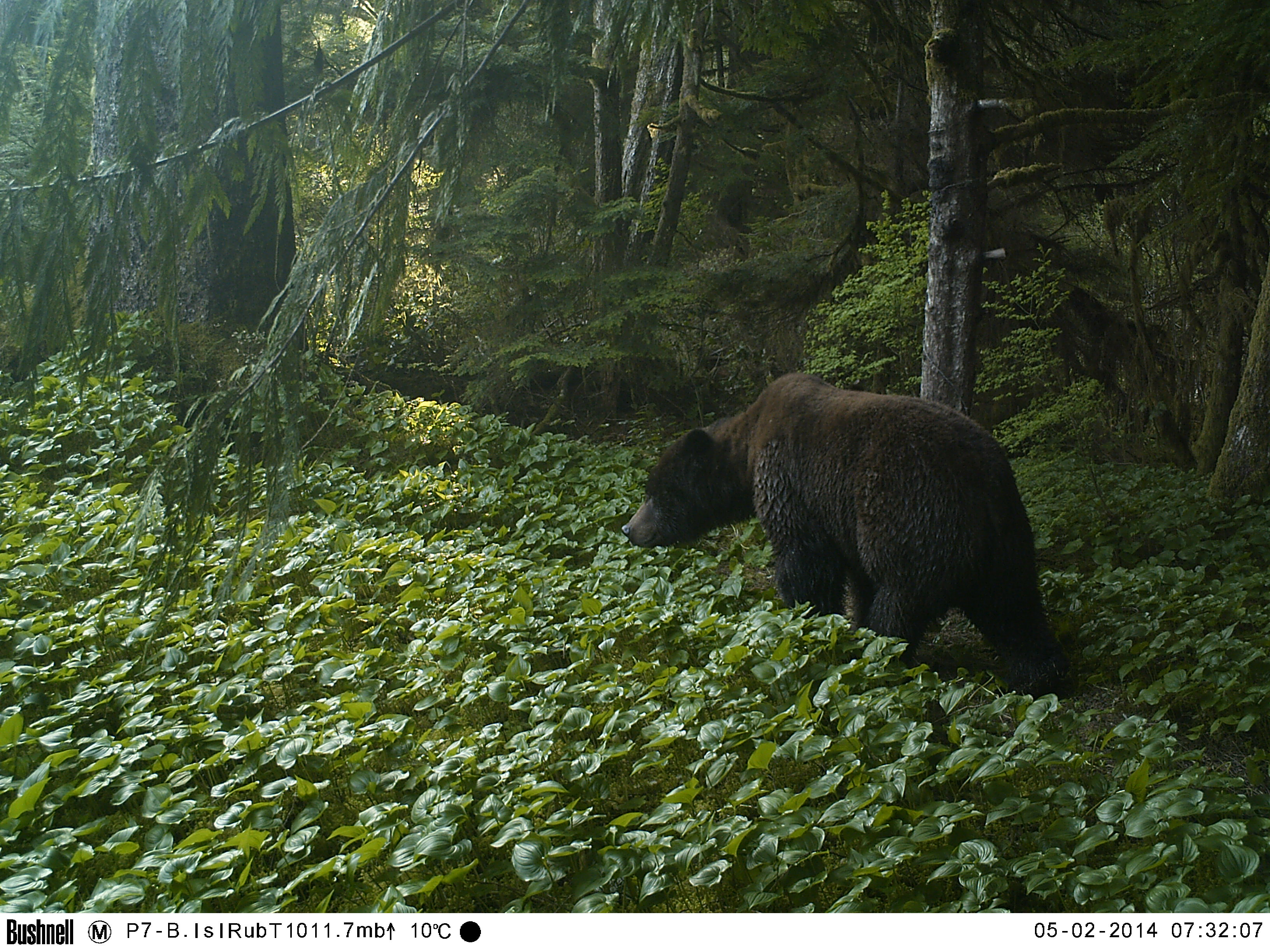
As apex consumers, grizzly bears are interconnected with both terrestrial and marine nutrient flows in the coastal rainforests of the Coastal First Nations and British Columbia, Canada. (Photo courtesy of Wuikinuxv Nation and Raincoast Conservation Foundation).
Adams credits the partnership led by her major professor, Chris Darimont of the University of Victoria and the Hakai-Raincoast Conservation Foundation — and by community leaders such as Douglass Neasloss, Chief Councillor of the Kitasoo/Xai’xais First Nation — as the basis for the framework they authored together.
The partnership grew out of the need to understand grizzly bear populations in the Great Bear Rainforest — 6.4 million hectares of coastal temperate forests nestled between southeast Alaska and Vancouver Island — and territories of the indigenous nations which make up the Coastal First Nations alliance.
For some of these First Nations, grizzlies represent an integral cultural figure as well as a major economic asset for ecotourism. However, three factors affect the sustainability of grizzlies in the Great Bear: trophy hunting, ample habitat, and salmon populations. Hunters eliminate maturing and reproductive-aged bears from the population, and the bears themselves are heavily reliant on local salmon migrations for survival; habitat degradation by industrial logging affects both salmon and bears.
“What we know on first principles is that when a system has less salmon, it has less grizzly bears,” says Chris Darimont in a documentary film about the research.
But what urged the First Nations resource managers to take action was the recently observed distribution shift of grizzlies onto coastal islands. This shift presented a major conservation dilemma: British Columbia regulations at the time only protected grizzly habitat on mainland habitats, because provincial records did not show grizzlies using island habitat. As such, the Great Bear Rainforest’s legal measures — which protect grizzly habitat on the mainland from industrial impacts — did not to extend to the islands.
What Neasloss and other First Nations leaders needed was to support indigenous histories of grizzly sightings with biological evidence. Working together with Adams and other University of Victoria researchers, community members were interviewed to distill the timeline of grizzlies appearing on islands — while genetic and isotopic analyses of collected bear hairs confirmed the relative population densities and diets for the island grizzlies.
The effort provided evidence to help British Columbia and First Nation governments move toward redrawing grizzly conservation boundaries, and the team continues to study the potential linkages between the island grizzlies, salmon runs, and environmental change.
In the film, Chief Councillor Neasloss reflects on their successes: “I would say that science and traditional ecological knowledge, or local knowledge, have really complemented each other very well.”
Asking Permission
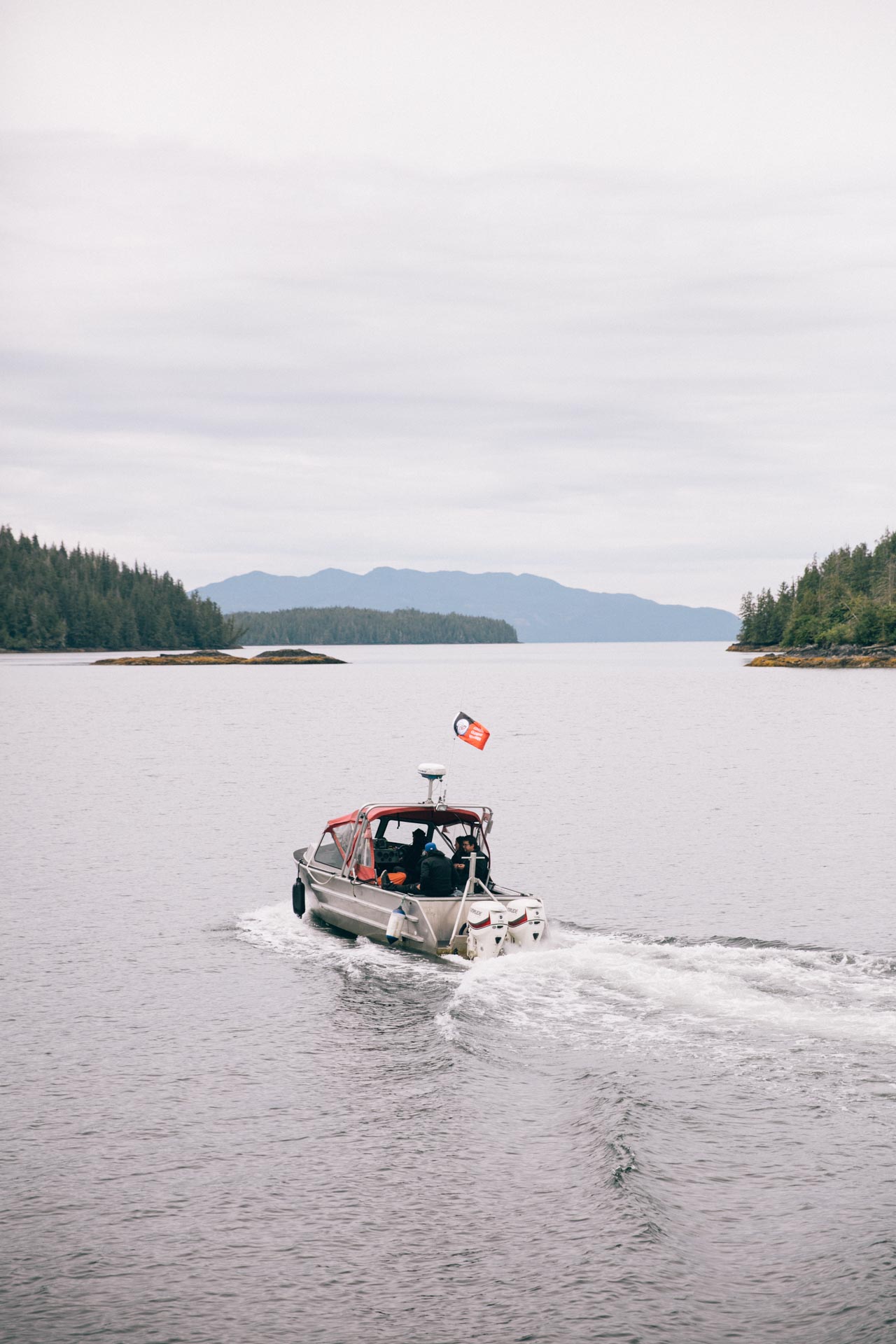
A Wuikinuxv Nation “Guardian Watchmen” vessel, flying the Coastal Stewardship Network flag of the Coastal First Nations alliance of indigenous governments. (Photo courtesy of Jeremy Koreski/The Sea to Cedar Initiative; reprinted with permission)
Both academic and community partners in the grizzly studies enjoyed the growing rapport and respect that built throughout the research process. Megan Adams says that was when Darimont and colleagues asked her to synthesize the lessons learned from the shared experiences of bear monitoring teams across the different territories.
“We thought, ‘Let’s build a tool, so we can share our reflections with other communities and other scientists in a humble way,’” recalls Adams, who admitted some initial trepidation at the responsibility. She sought the advice of another colleague, Jennifer Walkus of the Wuikinuxv First Nation, and together they tugged at how academic-community collaborations ought to be initiated, under ideal circumstances.
“And we realized, it begins with asking permission,” Adams says.
It was Walkus and Adams who decided to chart their recommendations in sequence of the four stages in a research process. “I had one page for each in my notebook — four pages, one page per step — and crammed each page full of everybody’s thoughts,” Adams laughs at the memory. “And eventually, we pared it all down.”
Since the framework’s initial publication as a peer-reviewed article and as the handbook chapter, Adams says it has been cited by researchers in Australia and New Zealand — two places also with extensive histories in indigenous-colonial relationships. Conversely, Adams says she looks to research out of Mexico and South America for new inspiration in community-engagement strategies.
As for her native Canada, Adams notes that in spite of past inequalities, the policy landscape offers increasing opportunities for academic-indigenous relationships to thrive. In British Columbia, for example, there are government-to-government processes built-in to give equal standing in decision-making both to the province and to First Nations. Elsewhere, the absence of colonial treaties — and the increasing devolution of legal power to indigenous governments — leave many natural resource management questions to be reconciled.
“So academics can help fill in the gap,” says Adams — provided, of course, that as “settler-academics” they respect the intrinsic dignity of their indigenous neighbors, and help teach that recognition to the world at large.
Marrying Knowledge
Jennifer Walkus, of the Wuikinuxv First Nation, can attest to the urgency for joining traditional ecological knowledge with Western science.
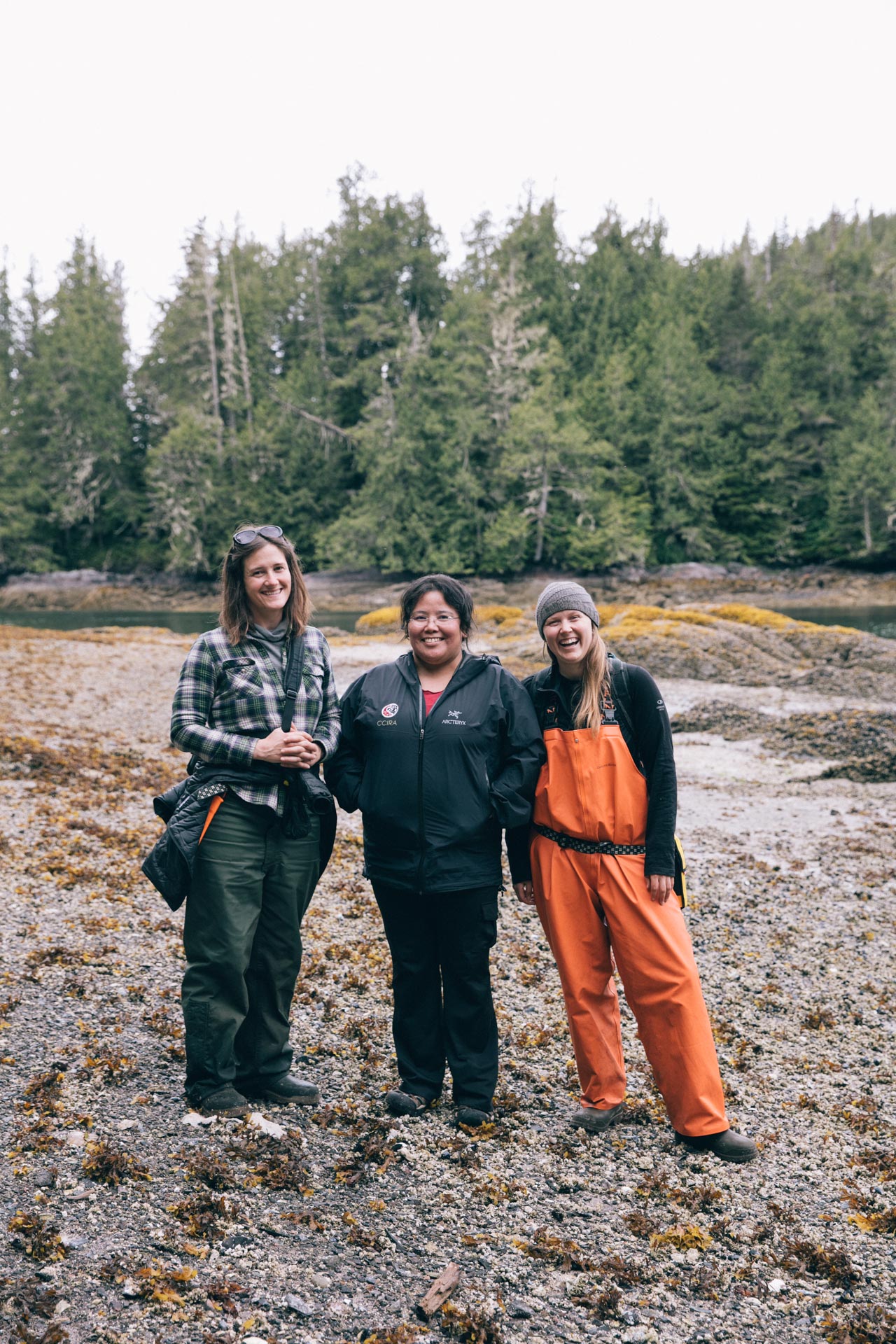
University of Victoria researcher Megan S. Adams (right), Wuikinuxv Nation researcher Jennifer Walkus (center), and Raincoast Conservation researcher Scott Rogers (left) on site in the Great Bear Rainforest of the Coastal First Nations and British Columbia, Canada. (Photo courtesy of Jeremy Koreski/The Sea to Cedar Initiative; reprinted with permission)
“It allows us to be taken more seriously by the government,” says Walkus, a former fisheries manager with the Wuikinuxv First Nation. She refers to the skepticism many community knowledge holders face when presenting evidence to non-indigenous authorities. In the case of the grizzly studies, she recalls that even Doug Neasloss — an elected leader in his own Nation — “was told he didn’t know what he was talking about” when he first reported the presence of bears on islands.
“So much of First Nation science is anecdotal — by being in those places and making all those observations — but that’s something academic science doesn’t do well, especially if the costs of having someone out there all the time doesn’t reap an immediate benefit,” she says.
Walkus hopes that anyone interested in working in First Nations territory will read the framework, and come to understand the value of leveraging both academic and indigenous world views. She says she feels for the academics mired in their own traditional ways of “how they’re supposed to frame science.”
“Community members aren’t tied to those lenses, so you gain a completely different way of thinking,” Walkus says. “Which can be challenging — but also can be quite rewarding!”
Walkus appreciates working with colleagues like Darimont and his students, who are open to the community conversations and organic interactions which ultimately improve the research design. And the comingled benefits extend far beyond: student researchers get to solve actual resource management questions and make real change, bringing generations of traditional knowledge to light for a wider audience while advancing their own careers in the publish-or-perish world.
If the latter benefit sounds exploitative, Walkus notes the legitimacy it provides for her community against bureaucratic institutions. “There’s not much traditional ecological knowledge that is recognized by science and used by science — the problem is there hasn’t been an easy way to fold that knowledge into Western science,” she says. “But if researchers can learn how to use this framework, then we’ll gain the collaborations and the access to present our traditional knowledge through science, in ways that can’t be refuted by the government.”
“The marriage of Western science and traditional knowledge is a huge step.”
Cultivating Humility
In the handbook version of the framework, Adams and coauthors open their chapter with a fitting quote:
The unexamined assumptions of the scientist both determine and limit what he or she will discover… Most people do not fully realize to what extent the spirit of scientific research and the lessons learned from it depend on the personal viewpoints of the discoverers.
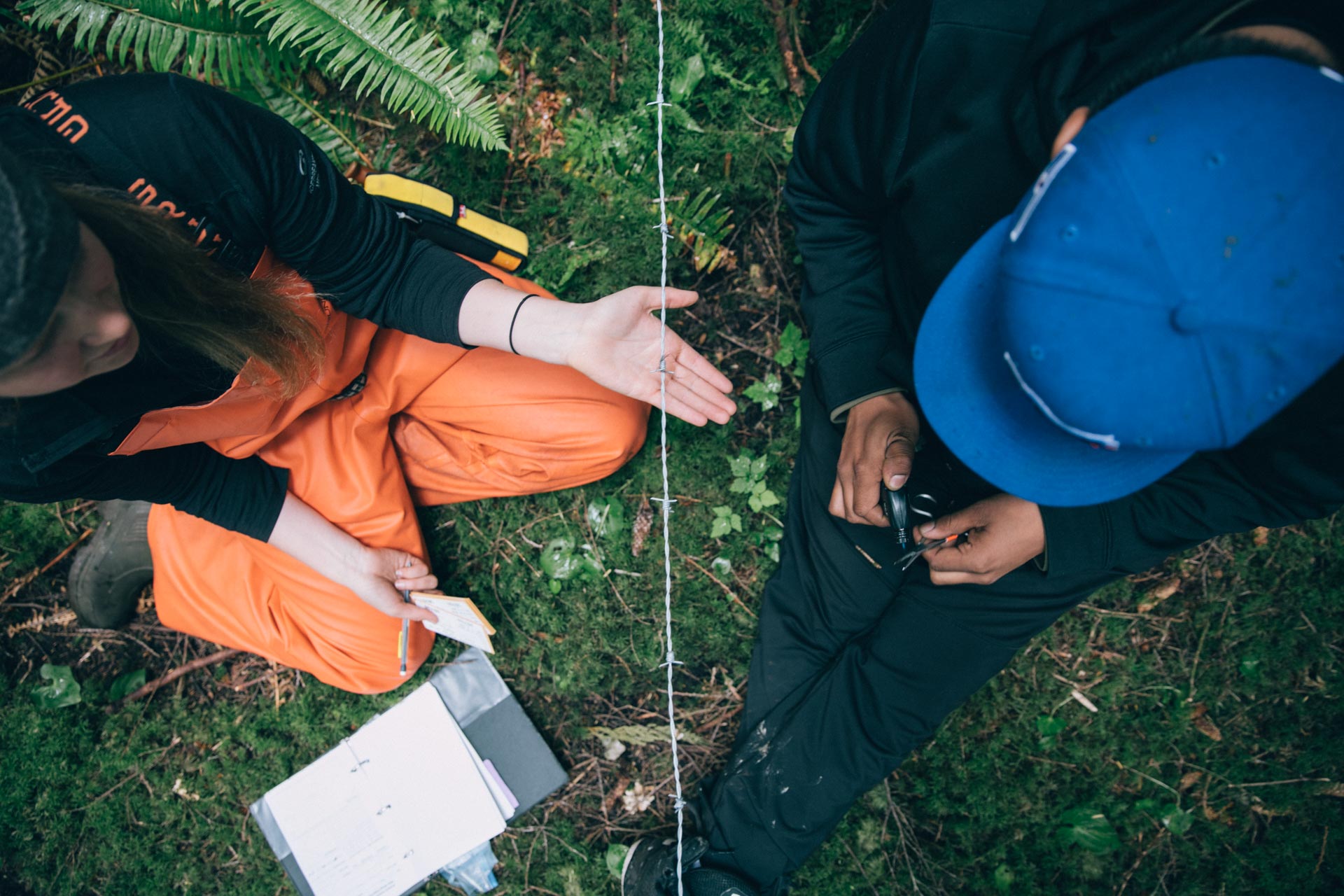
Isotopic and genetic analyses of bear hairs sampled from field traps (above) are just one sliver of the research plan jointly created by Coastal First Nations and University of Victoria partners to study shifts in grizzly populations and salmon runs. (Photo courtesy of Jeremy Koreski/The Sea to Cedar Initiative; reprinted with permission)
The quote, from Hungarian physiologist Hans Selye, was a frequent mantra of coauthor Jennifer Carpenter, a Heiltsuk First Nation collaborator who constantly challenged Adams — in the best ways.
“She would always say this to us every few months — ‘Unexamined assumptions!’ — and remind us to think about them in our work,” Adams says.
For Adams, growing up and working in a small rural communities has shaped her own viewpoints. She has seen outside scientists come in with their own research plan and world view, without consulting local knowledge — leaving residents befuddled as to why their expertise wasn’t consulted.
“I would urge young scientists to put themselves in the paths of communities,” Adams offers. “Take a humility and reality check of our academic degrees and the powers bestowed upon us. Have you challenged your assumptions? Have you challenged what you know and don’t know? Let’s get the undergrads on the ground. Let’s get young scientists to examine their assumptions.”
Adams admits she still had to learn these humbling lessons from working alongside First Nation colleagues and elders, or older, wizened fishermen, often in epically embarrassing fashion. But she is glad to have cultivated the self-awareness to “recognize that we are the stranger in the strange land.”
“How do we cultivate humility in science? I don’t see that often discussed,” says Adams. “I think if we want to cultivate conservation solutions, we need to be more open to different ways of asking — and different ways of knowing.”
Ben Young Landis is a contributing writer for Creative Science Writing and the Thriving Earth Exchange.
More Resources
Ideas for the framework were first presented by Adams and colleagues in a peer-reviewed article: Adams et al. 2014. Toward increased engagement between academic and indigenous community partners in ecological research. Ecology and Society 19(3): 5. doi: 10.5751/ES-06569-190305
The grizzly conservation studies which inspired the framework were documented in: Service et al. 2014. Indigenous knowledge and science unite to reveal spatial and temporal dimensions of distributional shift in wildlife of conservation concern. PLoS ONE 9(7): e101595. doi: 10.1371/journal.pone.0101595
Watch the short film “Great Bear” to learn about grizzly conservation management by Coastal First Nations and University of Victoria in the Great Bear Rainforest: https://vimeo.com/104956774
Watch the short film “Bear Witness” for Coastal First Nations perspectives on grizzly conservation and trophy hunting in the Great Bear Rainforest: https://www.youtube.com/watch?v=NDg24d8fF1Q





